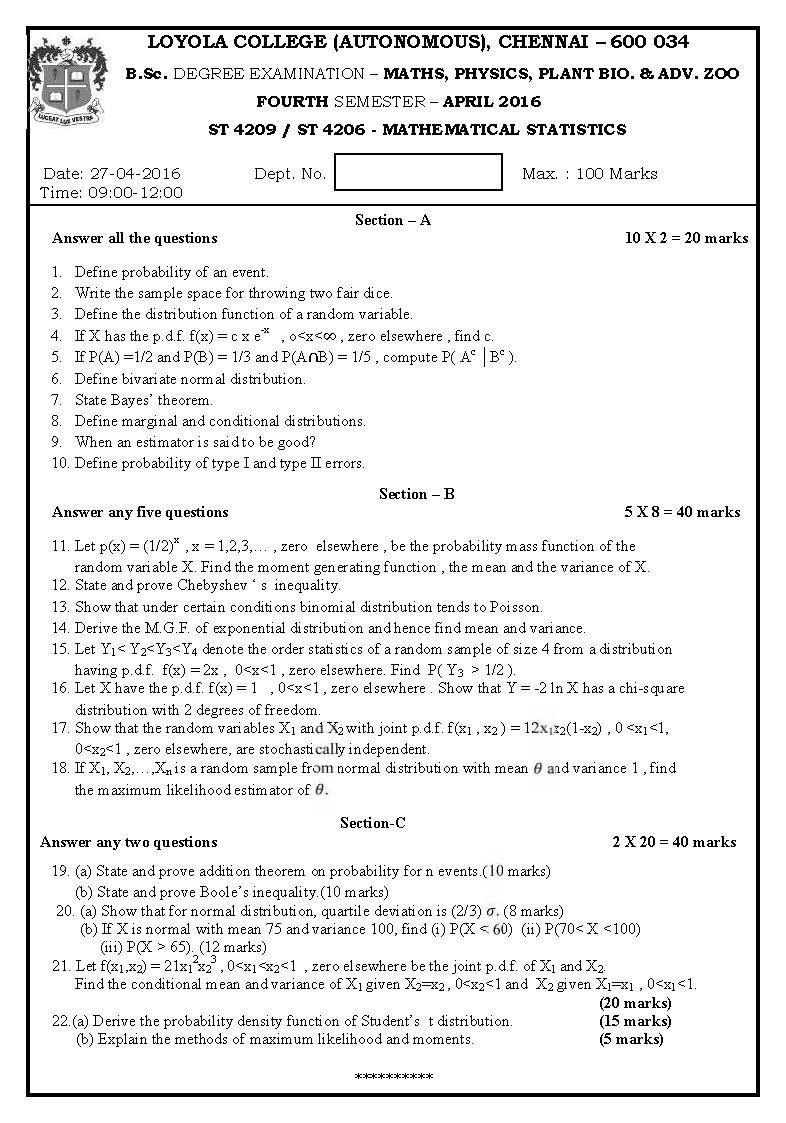LOYOLA COLLEGE (AUTONOMOUS), CHENNAI – 600 034
SUPPLEMENTARY SEMESTER EXAMINATION – JUN 2006
B.Sc. DEGREE EXAMINATION
ST 4201 – MATHEMATICAL STATISTICS
Date & Time : 28/06/2006/9.00 – 12.00 Dept. No. Max. : 100 Marks
Part A
Answer all the questions.
- Define probability set function.
- If A and B are two events , show that P(AnBc) = P(A) –P(AnB)
- If p(x) satisfies the conditions of a pdf of a random variable X, find the constant C where P(x) = C(2/3)x, x = 1,2,3,…
- If the mgf of a random variable is (1-2t)-1. Find the mean and variance.
- Let the random variables X1 and X2 have the joint pdf f(x1, x2) = 2, 0<x1<x2<1, zero elsewhere. Find the conditional pdf of X1 given X2 =x2.
- Define and unbiased estimator.
- If X1 and X2 are independent random variables with X1 ~ N(10,16) and X2 ~ N(15, 9). Find the distribution of X1 + X2.
- Let the new random variable Y be defined as Y = 8X3. Find the Jacobian of transformation.
- If the random variable X has a poisson distribution such that P[X=1] = P[X=2]. Find P[X=4].
- Define Type I and Type II errors.
Part B
Answer any five questions.
- Derive the mgf of Binomial distribution. Hence find the mean and variance.
- Let X and Y have the joint probability function.
(x, y): (1, 1) (1, 2) (1, 3) (2, 1) (2, 2) (2, 3)
P(x, y): 2/15 4/15 3/15 1/15 1/15 4/15
Find the correlation coefficient.
- If the skulls are classified as A, B and C according as the length is under 75, between 75 and 80, or over 80, find approximately assuming Normal distribution the mean and standard deviationa of a data in which A are 58 % and B are 38% and C are 4%.
- Three groups of children contain respectively 3 girls and 1 boy, 2 girls and 2 boys, and 1 girl and 3 boys. One child is selected at random from each group. Show that the chance that the three selected consists of 1 girl and 2 boys is 13/32.
- Let the pdf of a random variable be
f(x) = 3( 1 – x2) / 4 , -1<x<1, zero elsewhere. Find b2.
- Let X and Y have joint p.d.f.:
e-(x + y) x3y4
f(x, y) = , x > 0, y > 0
G4 G5
Find the p.d.f. of U = X / (X + Y).
-
- Discuss the properties of chi-square distribution.
- Obtain the method of moments estimator for the distribution with the p.d.f.
1/ (b-a), a ≤ x ≤ b
f(x) =
0 , otherwise.
Part C
Answer any two questions
- a). Derive the recurrence relation for the moments of Poisson distribution. Obtain b1 and b2.
b). State and prove the additive property of Gamma distribution with parameter a and p. ( 12 + 8 = 20)
- a). Derive the m.g.f. and hence find the mean and variance of Normal distribution.
b). Two random variables X and Y have the following joint probability density function
k (4 – x – y) ; 0 ≤ x ≤ 2; 0 ≤ y ≤ 2
f(x, y) =
0 , otherwise.
Find i). the constant k
ii). Marginal density functions of X and Y.
iii). Conditional density functions, and
iv). Var(X), Var(Y) and Cov (X, Y). (8 + 12 = 20)
- a). State and prove Bayes theorem
b). Let A, B and C are three events then derive the result for P(AUBUC).
c). A factory produces a certain type of outputs by three types of machine. The respective daily production figures are:
Machine I: 3,000 Units; Machine II: 2,500 Units; Machine III : 4,500 Units.
Past experience shows that 1 percent of the output produced by Machine I is defective. The corresponding fraction of defectives for the other two machines are 1.2 percent and 2 percent respectively. An item is drawn at random from the day’s production run and is found to be defective. What is probability that it comes from the output of
i). Machine I ii). Machine II iii). Machine III ? (7 + 7 + 6 = 20)
- a). Derive the pdf of F-distribution.
b). Obtain the mean and variance of Beta distribution.
